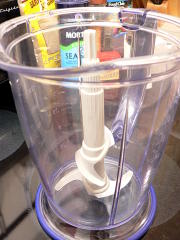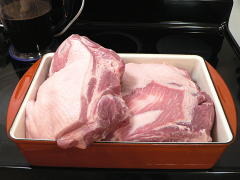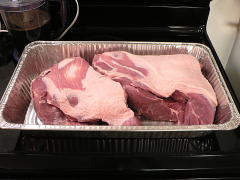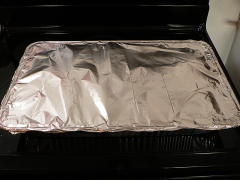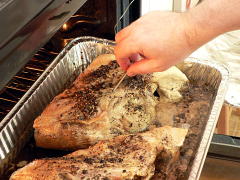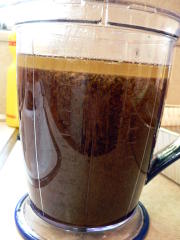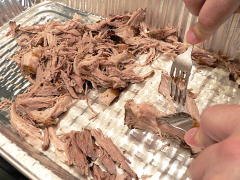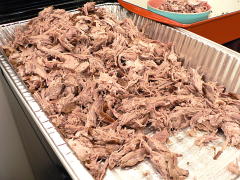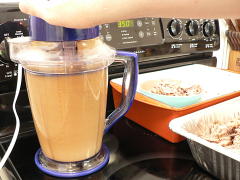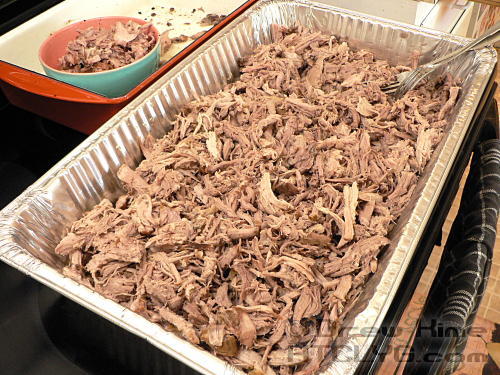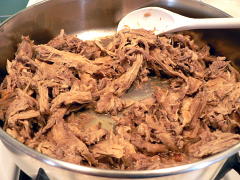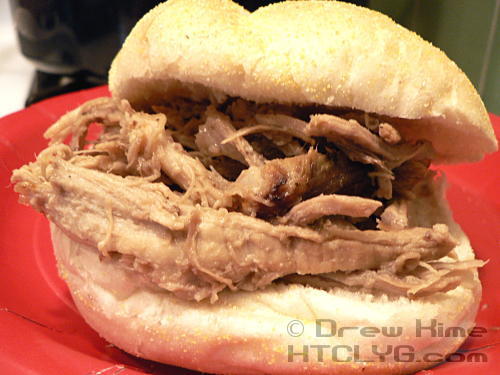The first time I had Carolina-style BBQ was at the Cleveland Rib Cook-off several years ago. I knew the sauce didn’t look like any of the others, so I gave it a try. It was amazing.
I’ve been looking for something similar ever since, but have only found a few examples, and they were like most commercial sauces: corn syrup and spices. So I finally decided to give it a try myself.
Ingredients
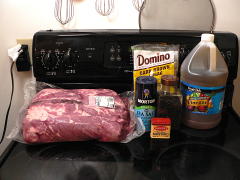 4 cups apple cider vinegar
4 cups apple cider vinegar
2 cups dark brown sugar
2 tablespoons peppercorns
1 tablespoon sea salt
1 teaspoon mustard powder
whole pork shoulder (~14 pounds)
Directions
I’m the only one in my house who likes really spicy food so I usually have to make things pretty mild, but my standards. (I’m trying to train the girls to like heat … not much luck yet.)
I also didn’t want to ruin 14 pounds of pork on a complete experiment. So this version came out really mild. Really good, but really mild. If you like heat, stay tuned for Take 2 — hopefully later this summer — or try my proposed changes at the end.
One last thing before I get started: I didn’t do this in a smoker. Go ahead, all you southerners reading this: Laugh, yell, curse my daddy for bringing me into this world … whatever you feel compelled to do. But I don’t own a smoker, so that makes it a little hard to cook something in a smoker, okay?
This method works in a regular oven, and is dead simple to do without babysitting it for 14 hours.
The sauce
If you’re using a smoker, you go with a dry rub. I’m braising, so I can just put everything in the sauce. Into the Ninja …
… pour the cider, sugar, peppercorns, salt and mustard and process until the peppercorns are well ground.
Next time I do this, I’ll combine all the dry ingredients first and process into a powder, then add the cider. It took forever to get the pepper cracked, and it still wasn’t ground as much as I’d like.
Rinse the pork shoulder and place in a large pan.
No, bigger than that.
That’s better.
UPDATE: Seriously, you want plenty of extra room in the pan. One of my readers tried this and the liquid overflowed her pan. It wasn’t a big deal right away, but she didn’t realize how much had spilled. The next time she tried to use the oven, she had flames inside. Use a big pan.
Put it in fat side up.
Pour the sauce over.
Cover tightly with foil.
Put in the oven at 250°F and don’t touch it for at least 7 hours. (Oh, did I forget to mention this takes all day? And you have to set the alarm for 6-freaking-a-m to have it ready for dinner?)
When you finally check it, you’ll think it looks ready to eat.
Check the internal temperature with a digital thermometer. It needs to be at least 190°F.
You may notice that’s much higher than I usually recommend for meat. But with pulled pork, you need all the connective tissue to melt. That’s what gives it the incredible tenderness, as well as the rich flavor. And it doesn’t happen until about 190°.
Mine wasn’t quite there yet, so it went back in. Don’t bother re-covering it with the foil. The pork will have given up a lot of liquid, and you want the sauce to start reducing.
If you’re watching the temperature closely, trying to time it for when your guests arrive, be prepared for a plateau just before it’s done. As the connective tissue starts breaking down the temperature won’t move until after it’s mostly done melting. Don’t keep opening the oven door to check or you’ll never get there.
When the temperature has been over 190 for at least 15 minutes go ahead and pull it. Try pulling it apart with a couple of forks, and it should come apart with no resistance.
If you had done this over a smoker all the fat would have cooked off the outside. It’s starting to melt on this one, but I wanted to get it all off without a lot of handling. So it went under the broiler for 15 minutes, until the fat was all crackling. Then it just lifted right off.
Transfer the meat to a separate pan, and pour all the juice into your blender. Or rather as much as will fit.
Yes, there’s more liquid after cooking than before. Let it settle, then pour the grease off the top.
While the juice is separating, start pulling the pork apart. At this point it’s tender enough to do it by hand. But unless you do this for a living, your hands probably aren’t up to handling this much hot meat. So use a couple of forks.
Pull of small chunks at a time or you’ll get overwhelmed by how much meat you’ve got.
When the meat is all ready, process the liquid again to get it nice and consistent.
And pour it over the meat.
Reserve a cup or two and set it out alongside the pan of meat. The large pan of meat.
If you have any left after the first picnic — 8 adults and 9 kids and we still had leftovers (okay, we had hot dogs, too) — divide it into gallon-size zip-top bags and add some of the remaining juice to each one.
When you want to serve it again, warm it up in a pan.
The “classic” way to serve this is on white bread or a plain white hamburger bun. But I like kaiser rolls.
One of my guests used to live in North Carolina, and she brought a little bottle of sauce she got from a friend. So I got to have a spicy one.
And that’s it.
Wait, no that’s not it. I said I would have some recommendations for people who like it spicier.
The dry rub recipes I saw mostly had about two tablespoons of pepper and a tablespoon of salt — just like my recipe — but for a 3-pound piece of pork. I figured that with a rub a lot of the seasoning drips off into the fire along with the fat, so I cut it back.
Next time, I’ll double the pepper, leave the salt where it was, and go up to a tablespoon of mustard powder. And by processing the dry ingredients before adding the vinegar, I’ll get even more of the pepper flavor.
I’ll keep you posted with “Take 2” when I do it again.
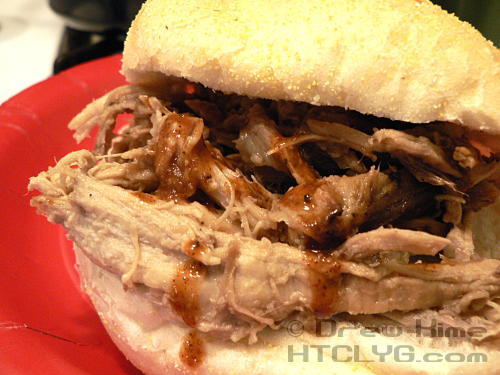
Ingredients
- 4 cups apple cider vinegar
- 2 cups dark brown sugar
- 2 tablespoons peppercorns
- 1 tablespoon sea salt
- 1 teaspoon mustard powder
- whole pork shoulder (~14 pounds)
Instructions
Combine all the dry ingredients in a blender or food processor and process until a fine powder. Add the cider vinegar and process again until mixed.
Rinse the pork and place fat-side-up in a large pan. Pour the sauce over. Cover tightly with foil, and place in a 250°F oven for at least 7 hours.
Remove the foil and check the internal temperature. Return to the oven until it is 190°F. Put under the broiler to crisp the fat on top.
Pour off and reserve the liquid. Separate the grease out and discard.
Remove the fat layer and pull the rest of the pork apart with forks or tongs. Pour the de-fatted liquid back in.
